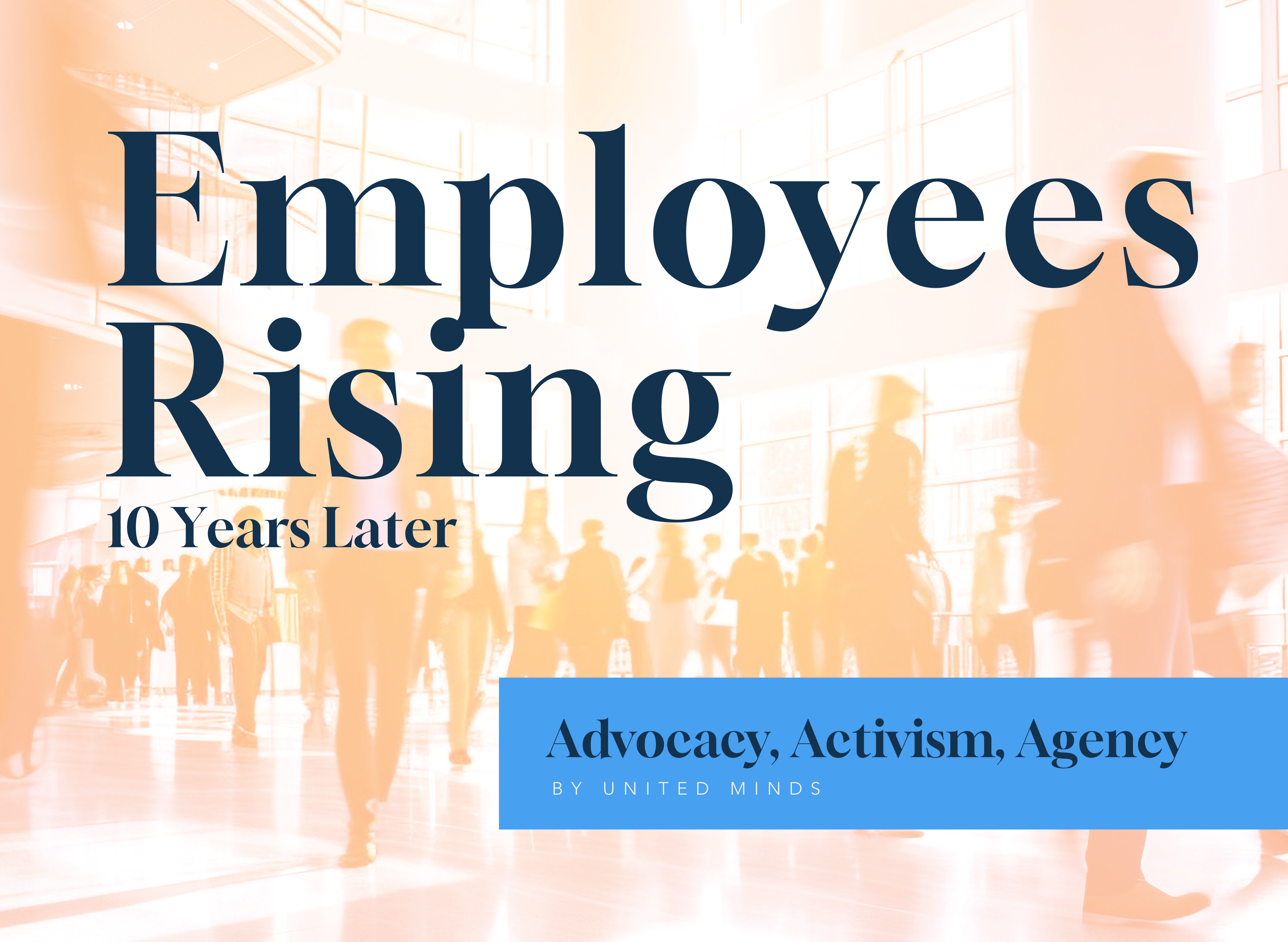Since 2014, United Minds has tracked, observed and catalogued employee engagement and advocacy through its Employee Rising series.
On balance, over the last decade changing dynamics in the employee experience have been a net positive for U.S. workers. This is reflected in our 2024 global study. Employees today are…happy, and employee satisfaction and positive perceptions of the workplace are up across the board. This is attributed in part to nearly two decades of investment in improving employee communications and engagement. Companies who have built strong foundations in basic communications, executive visibility, and employee listening are seeing dividends in overall performance, talent retention, and employee advocacy.
And yet, there is still work to be done.
While recent advances in workplace policies and approaches have prioritized a more flexible, empathetic, inclusive workplace, at the same time, in the U.S., there is a widening gap in income and pay inequality. Swings in labor relations and power dynamics that have created deeply embedded trust gaps between workers and their employers.
In boardrooms worldwide, “doing more with less” has become the mandate of the moment. Trade wars, tariff hikes and economic uncertainty are forcing hard choices – whether that’s reducing overhead, downsizing or streamlining operating models. This is becoming more apparent in M&A context where organisations often need to adopt a “do more with less” approach ahead of integration to ensure ROI from the deal.

Naturally, doing more with less can feel like a struggle particularly against a backdrop of several turbulent years. Yet again we’re upping the ante, turning up the dial on the pressure cooker -and it hurts. But what if we’re thinking about pressure all wrong? What if constraint isn’t the enemy – but the catalyst?
When De Beers faced market crisis in 2008, they discovered something unexpected. The pressure didn’t break them, it transformed them. Under constraint, they reimagined their entire business model, creating a more agile organisation that thrived when conditions improved.
This isn’t just luck. Studies show that moderate pressure increases focus, accelerates decision-making, and triggers innovation. The key isn’t reducing pressure – it’s building the resilience to harness it.
Four Keys to Turning Pressure into Performance
1. Build Emotional Commitment – shift from Loss to Possibility
People who see pressure as a challenge perform better than those who see it as a threat (Lazarus, 1991). Netflix’s shift from DVD rental to streaming wasn’t just strategic – it required deep emotional resilience. They helped their team see the loss of their core business as an opportunity to own the future.
Quick wins:
- Run reframing challenges – spend 10 minutes during team meetings identifying the challenges for the week, then help individuals to reframe them as opportunities.
- Celebrate small wins to maintain momentum – carve out 15 minutes at the end of each week to do a public ‘shout out’ for a win of the week, ideally using it as an opportunity for personal recognition too.
Going deeper
- Leadership resilience training – train people leaders on how to lead through prolonged pressure and uncertainty; focus on ideas such as reframing language and Carol Dweck’s ‘yet’ to build a growth mindset
- Reduce decision fatigue by automating small choices, breaking big tasks into chunks, and limiting unnecessary meetings.
2. Rational Understanding – demonstrate control in chaos
Research shows teams operating at 80-90% capacity make better decisions and waste less time than those at 60-70%. Why? Because constraints force better choices and a fixation on what’s within our control. When Toyota faced supply chain disruptions, they focused exclusively on what they could influence. This clarity helped them recover faster than competitors who tried to control everything.
Quick wins:
- Spheres of control workshop with your team – reset on priorities and purpose then identify your “control points” – what you can truly influence – and build out plans to Stop, Start and Continue from there.
- Create a simple “Priority Contract” with each team member. One page that clearly states their critical priorities, what they can stop doing, and where they have decision-making authority. Then hold regular reviews to eliminate low-value work
Going deeper:
- Map your team’s actual capacity (not their theoretical capacity) – Find the sweet spot between stretched and snapped. Trial a new resource model then create an action plan to close the gap.
- Prioritise key skill development – As Mihaly Csikszentmihalyi suggests ‘When pressure aligns with high skill level, people enter flow—a state of deep focus where they perform at their best.’ Identify gaps in team’s skillset and knowledge, then invest in top-ups e.g., 2-hour espresso sessions on set topics.
3. Collective experiences – winning together, failing together
Collective experiences help teams navigate high-pressure situations by fostering social support, shared resilience, psychological safety, and collaborative problem-solving, which reduces stress and enhances overall performance. When Airbnb lost 80% of their business overnight in 2020, they turned crisis into cohesion. They created transparent daily updates, shared decision-making, and made space for collective problem-solving.
Quick wins:
- Quality over quantity – with smaller budgets and limited time, make time together really matter. Invest in a few, short in-person experiences that build team spirit, embody the culture, and keep momentum.
- Use setbacks as collective learning opportunities – Openreach ran a ‘Fess up Fridays’ initiative where leaders shared their personal learnings in a group forum, sharing the blame and the learnings.
Going deeper:
- Co-create new ways of working – involve teams in a reset of your culture, behaviours and/or ways of working given the new team size and need to be more agile. Make it fun, engaging and creative building memorable positive shared experiences.
- Build cross-functional “pressure teams” – Break big challenges into 2-week missions, celebrate small victories publicly or create visible scoreboards that show progress.
4. Input and contribution: feedback and dialogue
Around 84% of employees consider psychological safety as one of the most valued aspects of the workplace; and it’s proven to be vital in reducing stress and building resilience. When Zara faced supply chain chaos, they amplified voices from the front line, demonstrating that their best solutions came from those closest to the problems.
Quick wins
- Create rapid feedback loops in weekly team meetings or with simple pulse surveys such as one question a week that reaches the entire team.
Going deeper:
- Run a simple psychological safety assessment within your team to identify barriers to speaking up
- Establish a champions network made up of a broad range of employees representing lower levels of the organisation to be your ear to the ground. Use them to co-create approaches and strategies for engagement and change
In today’s business environment, pressure isn’t going away. The winners won’t be those who try to eliminate or ignore it, but those who learn to harness it.
The question isn’t how to do more with less. It’s how to use constraints to unlock possibilities that abundance keeps hidden.
Return to office: the leadership challenge your business can’t afford to get wrong
The debate on the return to office (RTO) isn’t just a logistical question; it’s a litmus test for leadership in a post-pandemic world. Policies that once seemed straightforward—mandating when and where employees work—are now fraught with complexity, nuance, and trade-offs.

For organisations navigating this challenge, the stakes couldn’t be higher: the risk of alienating top talent, stifling innovation, or fracturing cultures is very real. But so is the opportunity to create a model of work that strengthens engagement, drives performance, and sets the foundation for long-term success.
Here’s how leaders can tackle the thorniest questions surrounding RTO, and why getting it right requires a bold, evidence-based approach.
The cost of mandates: breaking the social contract
Enforcing RTO mandates without a clear rationale or employee input risks eroding trust. Employees crave agency and autonomy, and overly controlling policies can feel like a breach of the unspoken social contract between employer and employee.
The fallout? Disengagement, attrition, and a workforce that feels infantilised rather than empowered.
Leaders must ask themselves: How can we balance business needs with employee expectations in a way that fosters trust and accountability?
It’s part of a bigger employee value proposition picture
The RTO debate feels like a decision in its own right, but the truth is that leaders instead of determining the RTO strategy in isolation, leaders must see it as part of a wider employee value proposition strategy.
It starts by identifying who and where the talent you need to attract and retain is, understanding what their expectations are and then designing a holistic employee value proposition that includes your route for RTO and hybrid working.
A rigid RTO stance risks alienating those who place a premium on flexibility, notably working parents, employees with caregiving roles, Gen Z workers who value independence and technological fluency, and individuals with disabilities for whom remote or hybrid work can offer essential accommodations.
Leaders must ask themselves: What talent do you need to attract and retain, what are their expectations and what is the holistic employee value proposition you offer?
The fairness equation
Fairness has emerged as a flashpoint in the RTO debate. Corporate employees who can work remotely often do, while frontline employees in retail, manufacturing, or healthcare have no such (or limited) flexibility. This disparity is a potential recipe for resentment and divide.
To bridge this gap, some organisations are redefining their cultures entirely – positioning corporate teams as “in service of” frontline workers. Others are introducing measures to create a sense of fairness, like shorter working weeks or improved benefits for frontline roles.
Leaders must ask themselves: What measures can we implement to address fairness head-on, ensuring every employee feels valued and respected?
The role of leadership
Returning to the office isn’t just about space—it’s about purpose. Employees, especially Gen Z, need to see the “why” behind RTO policies. They want clarity on what they’re expected to do in the office and how it aligns with organisational goals.
An arbitrary policy isn’t enough. What’s the purpose of those days? Are they for collaboration? Learning? Social connection? Without this clarity, the office risks becoming just another box to check.
Moreover, senior leaders must model the behaviours they want to see. Junior employees won’t buy into an RTO policy if they notice their managers are rarely present.
Leaders must ask themselves: What does it mean to ‘lead by example’ in a hybrid world and what can we do to ensure our actions match our words?
The cost to learning and development
We also know that with hybrid working comes a cost to learning and development, especially at more junior roles. It’s on both leaders and employees in their early careers to take responsibility for plugging the gap that working in person naturally provides for learning and growth opportunities.
Leaders must ask themselves: How can we create a culture of learning and collaboration in a hybrid world to support our continuous development and growth?
The hidden risks of RTO: innovation and well-being
Research shows that working remotely two days a week has little to no negative impact on productivity and even boosts job satisfaction. But it’s not without trade-offs.
Innovation, particularly across silos, often thrives on in-person interactions. Building trusted relationships and sparking spontaneous ideas are harder to replicate virtually.
At the same time, remote work has introduced the “cost of coordination”—an explosion of meetings that has left employees stretched thin and burned out.
We also know that as we learn to adopt AI into our day-to-day, we risk disconnecting from colleagues even further—turning to AI to ask questions and solve problems, rather than the humans in our teams.
Hybrid models that don’t address these issues risk exacerbating well-being and innovation challenges.
Leaders must ask themselves: Where is the sweet spot? How can we be deliberate about the way our teams work together to harness the benefits of both remote and in-person work?
The future of work
The return to office is not just a logistical exercise; it’s an opportunity to reimagine the future of work. Leaders who succeed will:
- Determine the RTO stance as part or a wider employee value proposition strategy: identify the talent you need to attract and retain, what their needs and expectations are and determine your hybrid working approach accordingly.
- Involve employees in decision-making: RTO policies imposed on employees rather than developed with them can expect to fail. Employees want agency, not mandates.
- Define the purpose of office time: Focus on collaboration, learning, and culture-building—not simply presence.
- Address fairness head-on: Acknowledge and address disparities between different employee groups.
- Equip middle managers: Managers are not the decision-makers but they are the linchpins of any RTO strategy. Yet they’re often the least prepared to navigate the complexities. Investing in their skills and confidence is critical.
- Make data-driven decisions: Use insights from productivity, engagement, and attrition data to refine policies over time. But we wary of strict tracking and monitoring of individuals that risks creating a rules-based culture of control and mistrust.
As Professor Thomas Roulet notes, “Hybrid work is an experiment in progress.” Organisations that approach it with humility, adaptability, and a commitment to fairness will not only navigate this transition—they’ll thrive in the new world of work.
The question isn’t whether to mandate a return to the office or not. It’s how to find the right solution for your organisation and launch it in a way that builds trust, drives performance, and sets the foundation for long-term success.
Learn more about United Minds’ approach and process to determining and launching an RTO position.
We’d love to know what you think, get in touch!
The past four years have seen significant change in the communications environment, particularly as it relates to the role and remit of the communications executive.
Following the 2020 COVID-19 pandemic and the rise in prominence of social justice issues initially motivated by the death of George Floyd, communications and corporate affairs executives stepped up to counsel the C-suite on stakeholder responses – including broader guidance around pandemic-related concerns and stances taken on racial justice and other social issues. An array of issue-based pledges and commitments put new scrutiny on corporations in the public arena, putting communicators in the hot-seat when it came to steering company leadership.
The pendulum has since swung back on social issues. Political polarization in the U.S. is at an all-time high, and increased public pressure from conservative activists like Robby Starbuck has made C-suite leaders more cautious on social issues. Employee activism has increasingly been met with a firm hand from corporations, and leaders have taken a harder stance on return-to-office mandates. In our work as counselors and advisors to the functional structure of the communications organization, we had one overarching question: Where does this environment leave the communications leader?
We spoke anonymously with a dozen large-company communications leaders with an eye toward assessing the change in scope, role, remit, function, and design for the communications organization associated with the myriad changes observed since 2020.
A natural straw man hypothesis for our research was that communications leaders might fade back into the background under a more cautious posture from their leadership. Instead, what we found was a more nuanced position, both more valuable and vulnerable than ever before. The past several years have heralded closer alignment between corporate communications and the rest of the C-suite. As their role has become more elevated, communications leaders have nonetheless been dependent on the CEO for position and influence. This piece has not changed: Specifically, many reported a refocusing on the “nuts and bolts” of the business, with fewer calories burned on issues and pledges, but more dialogue on the long-term advantage of purpose-based initiatives.
Our interviews revealed a shifting CEO agenda dictating changes to the communications function. Our interviewees pointed to a more complex regulatory environment, which has drawn the C-suite more deeply into the political environment under guidance from a broader corporate affairs function. They pointed to the pace of change, particularly as it relates to the rise of artificial intelligence, as a key mover on functional and structural organization. They called out the centralization and consolidation of businesses, and a broader trend toward efficiency and supply chain resilience, as driving factors both in their own organizations and in those they serve. And they spoke at length about the role of employee activism, particularly around core labor issues – pay equity, hours and working conditions, bargaining rights – which dictate new considerations and questions about the role and accountabilities of corporate leadership.

In 2014, United Minds first discovered an important global trend in brand reputation: employees in countries worldwide were – unprompted – speaking out on behalf of their organizations using their nascent social media platforms. Ten years and two additional studies later, we checked back on the state of employee activism, from current levels of engagement to perspectives on leadership. Our findings span 14 countries across six continents.
What we found should leave every employer asking how they can continue to upend and recalibrate employee engagement efforts so that they earn value and drive maximum impact: on satisfaction, on retention, on productivity and on advocacy.
Tech employees are motivated and satisfied, but wary of leadership and change.
United Minds asked employees across a number of industries about their experience at work, including relationships with colleagues, the organization and leadership. Across all industries people have positive sentiments towards their experience – 66% of people rate their experience as being positive. Of all the sectors we sampled, Tech had the most satisfied people. 77% of the people we spoke to in the Tech industry rated their experience positively.
Perhaps unsurprisingly, then, tech employees are the least likely to be open to new opportunities, with 29% saying they would be willing to chance jobs tomorrow vs. the 40% benchmark. At the same time, they are significantly more open to joining a union (58% vs. Benchmark 46%).
Gen Z employees are more optimistic, less satisfied and ready to take a stand.
In our latest study tracking 10 years of employee sentiments, we discovered most generations agree across 50 different statements. The good news is their experiences are largely positive—and yet, Gen Z (46%) along with Millennials (48%) are the most open to changing jobs tomorrow if they had the chance (vs. Benchmark 40%).
Low engagement for healthcare employees makes leaders’ fears of retention real. Over the past decade, our research proves that employee engagement has gone up across multiple industries, using a benchmark of 50 statements about workplace experience.
That’s good news for employees, right? For the most part, it is, but there’s one industry that lags behind: Healthcare.
Across industries, employees’ average agreement with 50 positive statements about workplace experience, organization and leadership is 66%. But for employees who work in healthcare, that rate is significantly lower at only 54% (-12%).
Download our Employees Rising Healthcare Briefing to review key findings of where healthcare employees’ experience in the workplace lags significantly behind the average of all employees and what this means for healthcare leaders.
Over the past six months, we’ve seen a surge in clients asking for support with their Gen-AI transformation efforts. There’s a growing recognition that Gen AI is not just another technological shift—it’s a transformation unlike any before. As businesses move from pilots to full-scale adoption, they can’t afford to overlook the psychological responses to this change. Working closely with heads of AI and digital transformation leaders, we’ve gained an understanding into why Gen AI adoption demands a distinct approach, how it diverges from past digital transformations, and why the human side of change is now more crucial than ever.

Why AI adoption needs a different approach
- It’s learning by doing like never before – in training teams around Gen-AI we learnt very quickly that Gen AI is best understood through hands-on exploration, as its power truly unfolds when people use it directly. Unlike past digital transformations, there are no strict guidelines; it’s intuitive, and personal discovery is essential for shifting mindsets and forming a new relationship with technology.
Overcome this by: Leaders need to trust their teams’ abilities to explore and grow. Encourage this with behavioral nudges that build confidence, and set up regular touchpoints for sharing successes, failures, and innovations.
- People come to AI with diverse perceptions, biases and expectations – Gen-AI is forcing people to reflect on the purpose and meaning of work, and critically their role within it (self-determination theory). The fear of the unknown, combined with the status-quo bias means people are reacting in more extreme ways, and there is far more loss aversion to overcome. Layer on top of that change fatigue from years of digital transformation efforts, and you’ve got yourself a pressure cooker for resistance.
Overcome this by: meeting people where they’re at, overcommunicating and being completely transparent (and human) about both the tools and their limitations, and about the change curve people may experience. Whatever you do, don’t let resistance hold you back, go where the energy is (because there’s as much curiosity as there is resistance) and create moments in time for celebration, excitement and engagement.
- Building the plane while it’s taking off couldn’t be more true – In many cases organisations don’t know what the future state looks like. They may have a few use cases which are essential in telling the story and showing potential, but the end goal is still unclear. Tools are evolving and being built every day, we’ve only just scratched the surface of what the possibilities are. For many, that’s exciting, for others it brings a sense of uncertainty and fear. Lewin’s Change Model which encourages organisations to unfreeze, change then refreeze must happen simultaneously or at record-speed to be successful. In many ways the ‘refreeze’ stage isn’t possible; people will constantly be in the state of flux. A growth mindset becomes essential.
Overcome this by: Tackling it and explaining it head on. Don’t try and pretend to have all the answers. Involve people in the process of defining the destination but leave that open to evolution as more knowledge is built.
- Safety is paramount (both psychological and legal) – creating a culture of constant experimentation is essential, and that is only possible if psychological safety is in place. People need to feel comfortable to try and fail, whilst critically understanding the guardrails, legal and ethical implications particularly when Automation Bias can lead us to over-trust AI outputs. It’s in many ways a juxtaposition, one that requires careful thought and a highly tailored approach.
Overcome this by: Be clear about the rules and open about the legal and compliance implications of using Gen AI. Invest in culture change efforts and behaviour change pilots to shift mindsets and ways of working. Critically, ensure leaders are driving accountability at the same time as creating the culture of psychological safety; a careful balance to strike.
- Leaders are learning too – whereas in most change programmes, top down leadership role modelling is the first priority, with Gen-AI adoption, the most senior leaders are often the last to adapt their ways of working. Of course, they know at an organisational level it needs to happen and are keen advocates, but on a personal level they’re often resistant to trying it themselves. This needs to be overcome, but at the same time your greatest influencers may not be who you expect.
Overcome this by: Invest in 1:1 coaching with leaders to help overcome any fear or resistance. Focus on creating a groundswell of influencers and champions at all levels of the organisation, use your Gen Z employees, give them a voice at the table of decision making, offer reverse coaching experiences for managers.
This is arguably the biggest shake up of work as we know it since the first Industrial Revolution. To overlook the human aspect of this change would be to admit defeat before you’ve even begun. Join us at the upcoming Business Change Conference on 27 November where we’ll be joined by in-house Gen-AI experts who’ll share their learnings of Gen-AI adoption.
#UnionizeStarbucks. #StarbucksWorkersUnited.
The collective outcry of disgruntled Starbucks employees this summer was just one of many examples of people taking their issues with working conditions to the court of public opinion – social media – that we have seen over the past few years. And they were effective. By month’s end, despite a US Supreme Court ruling that favored Starbucks, consumers were siding with the baristas, investors were selling their shares at a loss, and union negotiations were on track to deliver to workers a better contract.

Our new research shows that employees today are seeking agency – the ability to make an impact and the recognition for doing so – above all else from their employers. Those employers who do not offer opportunities for impact and value risk their employees grabbing it on their own terms, thereby changing consumer sentiment, influencing market valuations, and remaking their workplace.
This trend marks the latest evolution in how employees are engaging with their employers online; something we first observed in and have been tracking since 2014. That was the year of social campaigns so viral—remember the Ice Bucket Challenge?—they broke the Internet. Research we pioneered then revealed a startling development: engaging employees on social media resulted in brand messaging traveling 10X further than corporate channels. For organizations willing to invest in developing and empowering champion networks, the rewards were stratospheric—and the risks were low.
Fast forward to 2017, when we witnessed that advocacy morphing into something far more volatile. With one blog, you may recall, a disgruntled employee at Uber managed to dethrone its CEO. Research we conducted that year affirmed the trend: employees were gaining significant traction online by calling out their employer for unfair practices (real or perceived) or calling on them to take a stand on issues within or outside of the workplace. The risk/reward ratio, for employers, had dramatically reversed.
In 2021 and even more so today, we see that while winning brand advocacy is still possible, it’s by no means a given. To be sure, many employees have taken at least one action to advocate for their employers in the last 12 months—but these numbers have declined by close to or more than double digits since 2014. At the same time, employees’ activist positions have remained the same or slightly increased.

Faced with these headwinds, employers are not powerless. Our client work worldwide, bolstered by our ten years of research, highlights exactly how you can ride the momentum of employee advocacy while curbing the tide of rising employee activism.
- Understand and build a strategy to leverage the proven formula for building advocacy: multi-variate analysis shows that employees who feel 1) connected to and proud of their CEO, 2) that they have opportunities to develop and grow and 3) are generally satisfied with their workplace experience are significantly more likely to proactively advocate on behalf of their employers. Ensuring that employee engagement plans include robust executive visibility strategies, are tied closely to meaningful learning and development, and can be measured to ensure satisfaction will help improve outcomes.
- Address root causes of activism before they can sprout: employees who experience bad behavior in the workplace – from discrimination to micro aggressions – are understandably more likely to take a public position against their employer. There is no place for this toxicity at work, and employers must continue to do everything they can to identify it through culture risk assessments and remediate it by intervening where it persists.
Investing time in understanding what issues employees – and all important stakeholders – care about when it comes to navigating societal issues will also help get ahead of potential activism. A strong societal issues framework that balances stakeholder perspectives with organizational values and the realities of the business will allow for better coordinated planning as expected and emerging issues come up.
Based on the above, the questions we advise our clients to consider include:
- Do we create alignment across and points of connection with (C-suite, region, unit, site)?
- Do we have a plan for navigating societal issues to ensure consistency, speed and alignment?
- Are we consistently revisiting employee life-cycle from on-boarding to continued engagement with alumni for opportunities to strengthen engagement, learning and development?
- Are we facilitating mentorship and sponsorship across the organization?
While the proven approaches increasing employee advocacy and mitigating activism are relatively straightforward, they are anything but simple. We work closely with our colleagues at United Minds across North America, South America, Asia Pacific, Europe, Africa, and the Middle East to help clients anticipate, minimize and address organizational risk, while at the same time improving employee engagement, satisfaction, and ultimately, performance.
Published originally in Compass for the Chaos.


